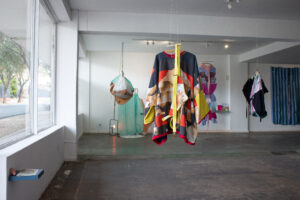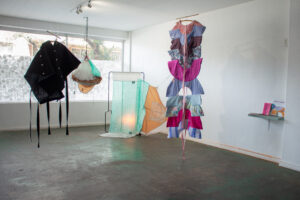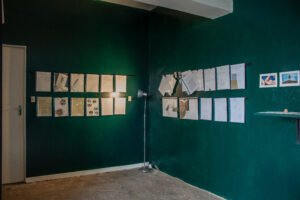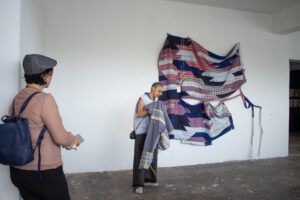
Gamedze, who creates garments under the brand For the Afterlife, confirms that this is a lifetime project, one that she believes will continue to evolve through the sharing of the garments and journaling, just as a book is passed down and shared.
Keke Nkadimeng on the work of Thulile Gamedze
Installation view
Literature Worn and Felt:
A review on Thulile Gamedze’s After Library
After Library is an exceptional thought-provoking project by “librarian”, designer and artist Thulile Gamedze who also holds a M.Phil. from the University of Cape Town. I like many others am amazed by Gamedze’s cross-disciplinary approach to her research interests. Reflecting on the inception of this project the librarian recalls having an epiphany whilst reading a text “On Death” which appears at the end of Steve Biko’s I write what I like.
The striking print on Biko’s tie as well as the density of the book is what drew Gamedze to posing a fundamental question; “how could we share (and collectively wear) the ‘problem’ of hard texts?” This thought-provoking question is what led Gamedze to creating a deeply speculative and conceptual world where clothes and historical educational texts could coincide in a harmonic way-through the instrument of time, the presence of touch and the weariness that comes with the endurance of both.
Installation view
As Gamedze explains, she methodically chose seven collaborators, all close friends of the librarian, including her sister, Thandi Gamedze—a poet and theologian. Each collaborator was asked to propose an existing text, selected from Southern Africa, that they regarded as politically, historically, or artistically significant in the contemporary moment. The chosen text was to be accompanied by concept notes, or an idea related to it, which would inform the creation of a library garment (Gamedze, 2025)
One could say that each text metaphorically serves as its own shade of colour between Gamedze and each collaborator. Just like the colour blue is distinct from the colour red, each book gave birth to a unique design that was entirely its own. Although each garment was different, they all served their purpose in shaping a world where thought provoking texts and clothes collided, creating a beautiful hue of storytelling. The books selected for this project each engage with deeply political themes, reflecting issues of identity, power, and societal structures. From K. Sello Duiker’s A Quiet Violence of Dreams 2001 to the thought-provoking Kairos Document: A Challenge to the church 1985, each work challenges the status quo and gives voice to marginalized narratives.
Library files for AL001-007 in the library room
With each of the garments cleverly designed to be worn in multiple ways, this process thoughtfully encapsulates Gamedze’s approach to deconstructing and reconstructing narratives of marginalized voices within the southern African context. Gamedze’s ability to blend the past with a discourse on how to create new futures where historical and colonial structures can be deconstructed and reconfigured is one that requires an exceptional level of critical thinking.
What truly makes this project a truly immersive, and fascinating experience is the lifelong network that Gamedze has managed to cultivate. To further broaden the process of the project each collaborator was to wear the garment, write and journal about their time in it and furthermore loan it to a friend that would carry on the process of wearing and archiving. A fundamental aspect of archiving meant filling out a library form that entailed information about the loaner of the garment. Through this process Gamedze cleverly introduces an element of value through touch and memory. It’s this very process that embodies the characteristics of reading and sharing books. This unexpected and equally crucial link to performativity is what makes Gamedze a conceptual thinker ahead of the times. I think that the idea of conceptual art can sometimes escape the audience due to its intrinsically abstract nature. Because of this I believe that conceptual artists need to consistently put intention at centre of what they do. Gamedze’s After Library is a true example of what happens when speculative and abstract worlds manifest through practical, thorough and intentional lenses. After library is a project that carries design and art beyond the confine of four walls. Gamedze has beautifully created a self-expansive and educational world built on the foundation of collaboration and a deep respect and appreciation for the intellectual property of those around her.
Thuli leading walkabout on 22.03 backgrounded by placket sketch (femme 4 femme), 2025 used men’s shirts, collaged and quilted with central mega button placket
The exhibition was open at the Ellis House Gallery from March 21st to March 28th, with a walk about and closing event that allowed the audience to engage directly with the garments through touching as well as wearing the garments. Gamedze, who creates garments under the brand For the Afterlife, confirms that this is a lifetime project, one that she believes will continue to evolve through the sharing of the garments and journaling, just as a book is passed down and shared. The library, in her eyes, is not just for this generation, but for those that will come after, creating a legacy of shared knowledge, memory, and resistance.
My name is Keke Nkadimeng, I am a curator and researcher based in Johannesburg. I am also a research fellow at The New Centre for Research & Practice.
Photos: Gillian Fleischmann/Copyright tex: writer



